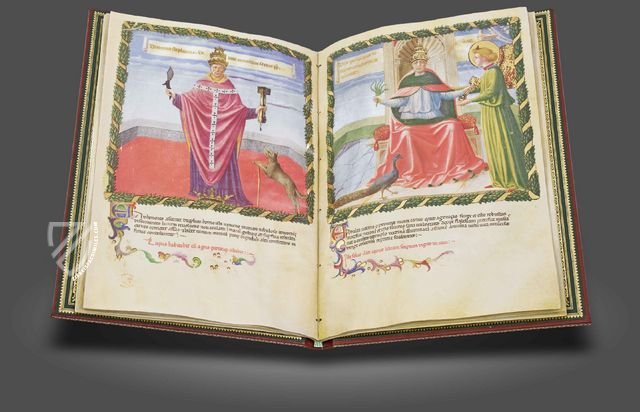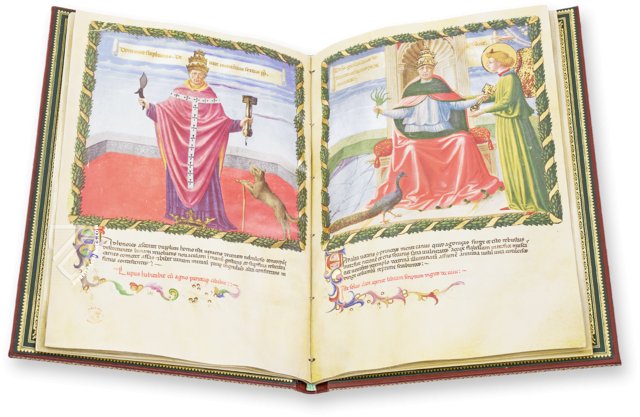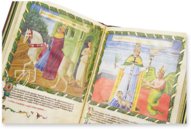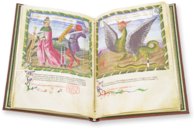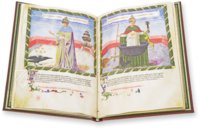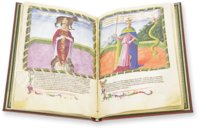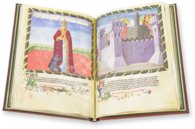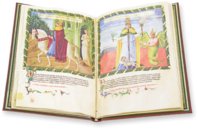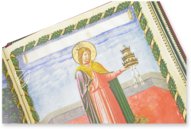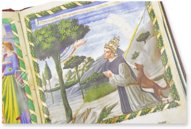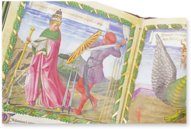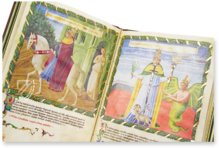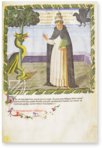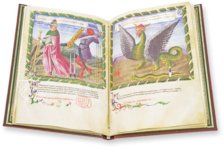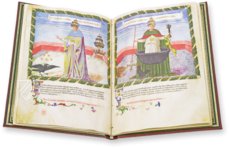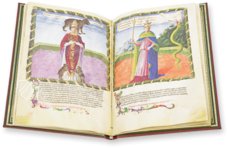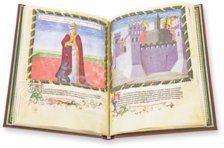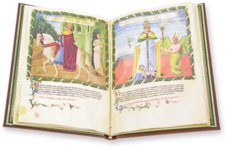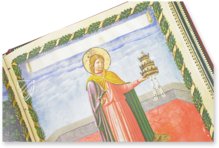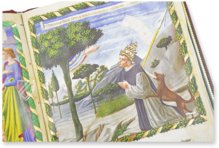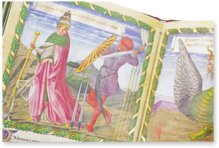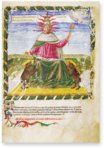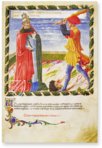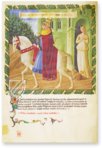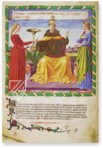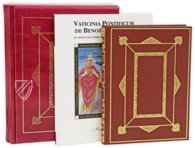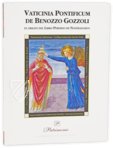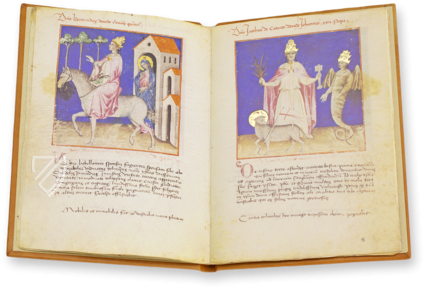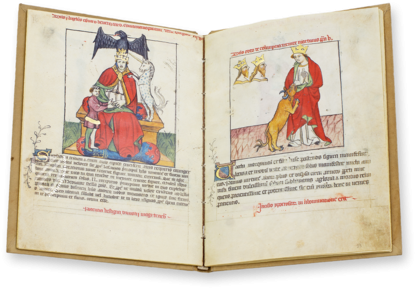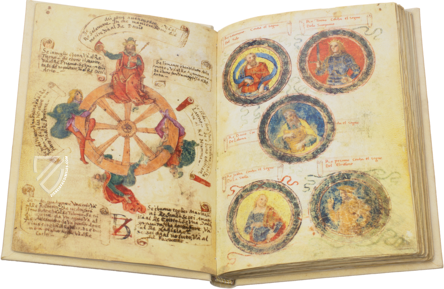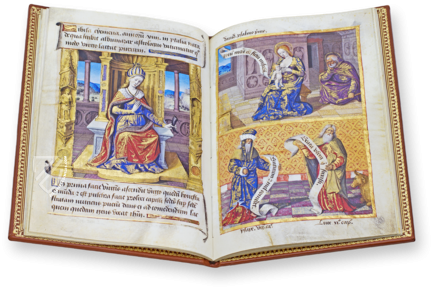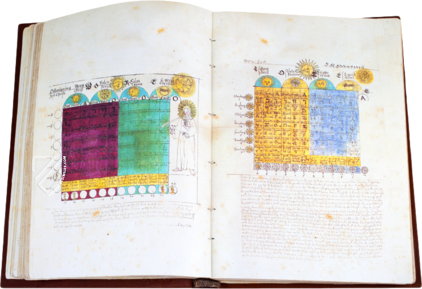Harley Vaticinia de Pontificibus
(3,000€ - 7,000€)
Created by Benozzo Gozzoli, the Vaticinia Pontificum is considered to be a nearly-perfect work of Italian manuscript art. The miniatures of the text, which still exhibit some lingering Gothic influence, are second to none for their refinement and use of perspective. The content is also noteworthy: thirty prophecies related to the destiny of the papacy and the Church attributed to the Italian mystic Gioacchino da Fiore. What is more, the work served as inspiration for Nostradamus' Lost Book of the Prophecies, making it the most significant prophetic manuscript to survive today. Benozzo Gozzoli, one of the most famous and sought-after painters of the Tuscan Quattrocento, masterfully presented Fiore’s prophecies in a uniquely artful and polished series of miniatures.
Harley Vaticinia de Pontificibus
Benozzo Gozzoli’s Vaticinia Pontificum is an enthralling codex, in many ways the perfect work, not only by its beauty and notable quality of the illustrations, but also for the mysteries and hidden keys within its pages and images. Vaticinia Pontificum is considered to be the father and iconographic origin of Nostradamus’ work and his worldwide famous manuscript, made in 1629, almost two hundred years after the Vaticinia Pontificum, also known as the Lost Book of Nostradamus. It's the most famous manuscript of prophecy and contains a series of thirty prophecies related to the destiny of the papacy and the Church attributed to the Italian mystic Gioacchino da Fiore. The work contains symbolic connections with past historic events of the Vatican that have already been verified, as well as events of the modern church, and could even unveil the keys of the future of humanity.
The Keys of Humanity’s Future
The similarity of the Vaticinia Pontificum, particularly when one compares the images, with the Lost Book of the Prophecies by Nostradamus, makes it clear that Nostradamus’ work is a copy based on the British Library’s “Harley 1340.” The ten last predictions express the confidence in the arrival of a near “angelical pope” or a series of angelical popes, meaning, a saintly and purifying pope, a charismatic figure that differs himself from the rest of his predecessors by his moral integrity and high spirituality, and also that he opens a profound phase of reform within the Church. This could be related to the figure of Saint John Paul II, and even the present Pope Francis I. The miniature referring to this prophecy corresponds to the folio 13v: the naked pope. It represents a spectacular praising of the humble spirit embodied by an angelical pope that has been stripped of all of his possessions and the temporal power, with the conviction that the papacy could only be renewed through poverty and the dispossession of mundane belongings.
Benozzo Gozzoli – Genius of Universal Painting – Illustrated this Mysterious Manuscript
Illuminated by Benozzo Gozzoli, genius of the universal style of painting and author of the Journey of the Magi, who made majestic frescos at the behest of Piero di Cosimo that present Lorenzo the Magnificent riding a horse as one of the Magi, which is kept in the Magi Chapel in the Medici Palace, Florence. Benozzo Gozzoli was one of the most famous and sought-after painters of the Tuscan Quattrocento and thanks to his longevity, around one hundred pictorial works can be attributed to him. Even though he was prolific with panel painting, many reredos, polyptychs, and altars from his studio survive today; Gozzoli stood above all in his talent for mural painting with frescos. In his works, with some lingering Gothic influences, the influence of his master Fra Angelico can be seen clearly, especially in the brightness and intensity of the color use, or the softness in the treatment of the faces. Nowadays, his works are in the most important museums in the world: the Louvre Museum, The National Gallery, The Metropolitan Museum of New York, and the Vatican, amongst others.
Codicology
- Alternative Titles
- Vaticinia de Pontificibus
Vaticinia de Summis Pontificibus - Size / Format
- 32 pages / 28.5 × 19.5 cm
- Origin
- Italy
- Date
- 1431 – ca. 1447
- Epochs
- Style
- Genre
- Language
- Script
- Gothic Textura
- Illustrations
- 30 three-quarter page miniatures with captions and full borders as well as 30 initials with foliate extensions, illuminated throughout in bright colors and gold
- Content
- A series of thirty prophecies related to the destiny of the papacy and the Church attributed to the Italian mystic Gioacchino da Fiore
- Artist / School
- Joachim of Fiore
Master of San Miniato
Benozzo Gozzoli
Harley Vaticinia de Pontificibus
Pope Benedict XI
Although only reigning for less than a year, Benedict XI was significant for being the last pontiff before the Avignon Papacy, named by contemporaries as the Babylonian Captivity in a reference to the destruction of the First Temple and subsequent enslavement of the Israelites. Originally a Dominican monk, he was venerated for his holiness by the faithful, miracles have been reported at his tomb, and he was beatified in 1736. It was rumored in his day that he was poisoned.
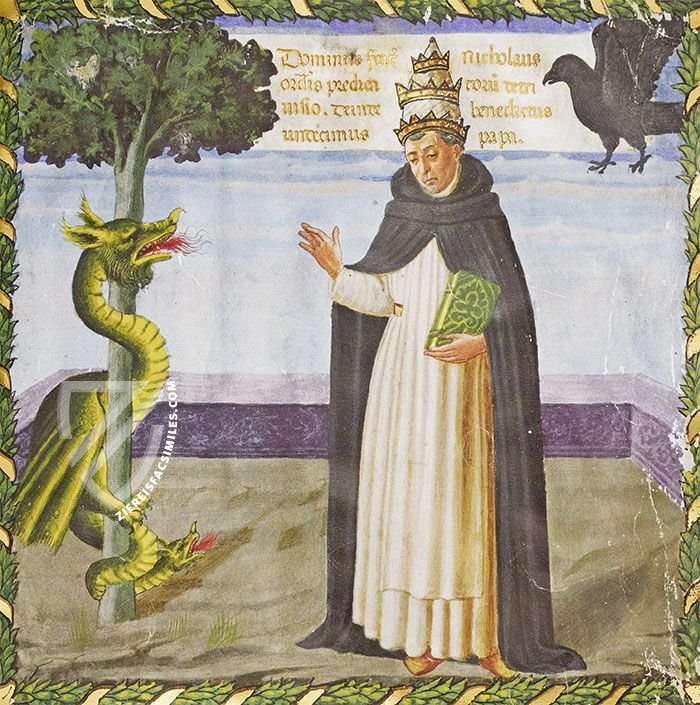
Harley Vaticinia de Pontificibus
Pope Urban VI
After finally returning to Rome from Avignon, the Catholic Church almost immediately became torn by the Western Schism. Urban VI was too austere and stern for the luxury-loving cardinals, who soon elected an antipope – Clement VII. This manuscript reflects the animosity felt by the Florentines toward Urban VI, to whom they already had been forced to pay restitution after the costly War of the Eight Saints.
This grotesque hybrid creature of a dragon with feathered wings and a man’s head is meant to embody the disastrous papacy of Urban VI. Various symbols are used by the artist to illustrated Urban’s wickedness: a forked beard, the elongated eyes of a donkey, a snake, a scorpion, and a dagger stuck in the ground. It is a gorgeous miniature nonetheless.
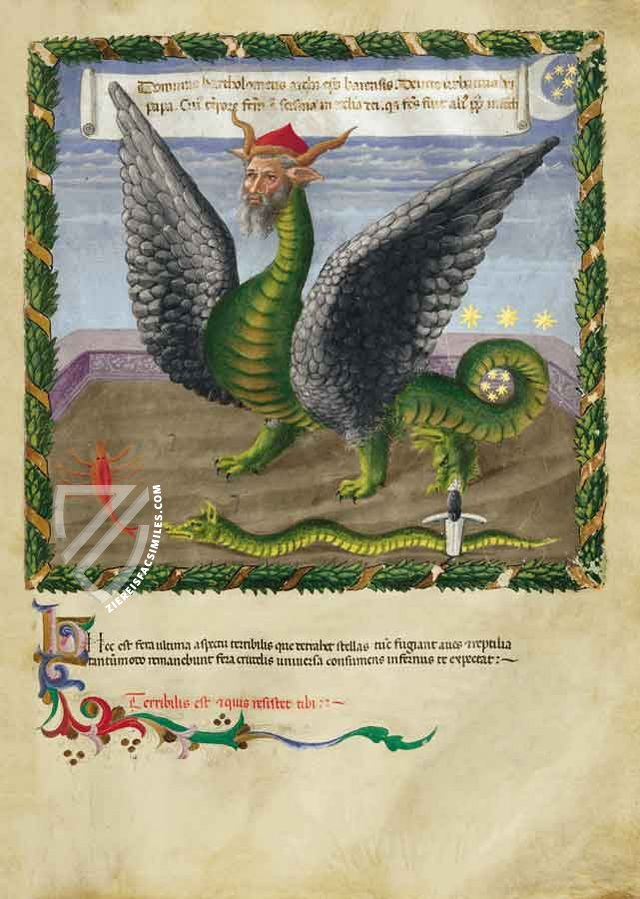
#1 Vaticinia Pontificum de Benozzo Gozzoli
Languages: Spanish (printed), English (PDF)
(3,000€ - 7,000€)
- Treatises / Secular Books
- Apocalypses / Beatus
- Astronomy / Astrology
- Bestiaries
- Bibles / Gospels
- Chronicles / History / Law
- Geography / Maps
- Saints' Lives
- Islam / Oriental
- Judaism / Hebrew
- Single Leaf Collections
- Leonardo da Vinci
- Literature / Poetry
- Liturgical Manuscripts
- Medicine / Botany / Alchemy
- Music
- Mythology / Prophecies
- Psalters
- Other Religious Books
- Games / Hunting
- Private Devotion Books
- Other Genres
- Afghanistan
- Armenia
- Austria
- Belgium
- Belize
- Bosnia and Herzegovina
- China
- Colombia
- Costa Rica
- Croatia
- Cyprus
- Czech Republic
- Denmark
- Egypt
- El Salvador
- Ethiopia
- France
- Germany
- Greece
- Guatemala
- Honduras
- Hungary
- India
- Iran
- Iraq
- Israel
- Italy
- Japan
- Jordan
- Kazakhstan
- Kyrgyzstan
- Lebanon
- Liechtenstein
- Luxembourg
- Mexico
- Morocco
- Netherlands
- Palestine
- Panama
- Peru
- Poland
- Portugal
- Romania
- Russia
- Serbia
- Spain
- Sri Lanka
- Sweden
- Switzerland
- Syria
- Tajikistan
- Turkey
- Turkmenistan
- Ukraine
- United Kingdom
- United States
- Uzbekistan
- Vatican City
- A. Oosthoek, van Holkema & Warendorf
- Aboca Museum
- Ajuntament de Valencia
- Akademie Verlag
- Akademische Druck- u. Verlagsanstalt (ADEVA)
- Aldo Ausilio Editore - Bottega d’Erasmo
- Alecto Historical Editions
- Alkuin Verlag
- Almqvist & Wiksell
- Amilcare Pizzi
- Andreas & Andreas Verlagsbuchhandlung
- Archa 90
- Archiv Verlag
- Archivi Edizioni
- Arnold Verlag
- ARS
- Ars Magna
- ArtCodex
- AyN Ediciones
- Azimuth Editions
- Badenia Verlag
- Bärenreiter-Verlag
- Belser Verlag
- Belser Verlag / WK Wertkontor
- Benziger Verlag
- Bernardinum Wydawnictwo
- BiblioGemma
- Biblioteca Apostolica Vaticana (Vaticanstadt, Vaticanstadt)
- Bibliotheca Palatina Faksimile Verlag
- Bibliotheca Rara
- Boydell & Brewer
- Bramante Edizioni
- Bredius Genootschap
- Brepols Publishers
- British Library
- C. Weckesser
- Caixa Catalunya
- Canesi
- CAPSA, Ars Scriptoria
- Caratzas Brothers, Publishers
- Carus Verlag
- Casamassima Libri
- Centrum Cartographie Verlag GmbH
- Chavane Verlag
- Christian Brandstätter Verlag
- Circulo Cientifico
- Club Bibliófilo Versol
- Club du Livre
- CM Editores
- Collegium Graphicum
- Collezione Apocrifa Da Vinci
- Comissão Nacional para as Comemorações dos Descobrimentos Portugueses
- Coron Verlag
- Corvina
- CTHS
- D. S. Brewer
- Damon
- De Agostini/UTET
- De Nederlandsche Boekhandel
- De Schutter
- Deuschle & Stemmle
- Deutscher Verlag für Kunstwissenschaft
- DIAMM
- Droz
- E. Schreiber Graphische Kunstanstalten
- Ediciones Boreal
- Ediciones Grial
- Ediclube
- Edições Inapa
- Edilan
- Editalia
- Edition Deuschle
- Edition Georg Popp
- Edition Leipzig
- Edition Libri Illustri
- Editiones Reales Sitios S. L.
- Éditions de l'Oiseau Lyre
- Editions Medicina Rara
- Editorial Casariego
- Editorial Mintzoa
- Editrice Antenore
- Editrice Velar
- Edizioni Edison
- Egeria, S.L.
- Eikon Editores
- Electa
- Emery Walker Limited
- Enciclopèdia Catalana
- Eos-Verlag
- Ephesus Publishing
- Ernst Battenberg
- Eugrammia Press
- Extraordinary Editions
- Fackelverlag
- Facsimila Art & Edition
- Facsimile Editions Ltd.
- Facsimilia Art & Edition Ebert KG
- Faksimile Verlag
- Feuermann Verlag
- Folger Shakespeare Library
- Franco Cosimo Panini Editore
- Friedrich Wittig Verlag
- Fundación Hullera Vasco-Leonesa
- G. Braziller
- Gabriele Mazzotta Editore
- Gebr. Mann Verlag
- Gesellschaft für graphische Industrie
- Getty Research Institute
- Giovanni Domenico de Rossi
- Giunti Editore
- Graffiti
- Grafica European Center of Fine Arts
- Guido Pressler
- Guillermo Blazquez
- Gustav Kiepenheuer
- H. N. Abrams
- Harrassowitz
- Harvard University Press
- Helikon
- Hendrickson Publishers
- Henning Oppermann
- Herder Verlag
- Hes & De Graaf Publishers
- Hoepli
- Holbein-Verlag
- Houghton Library
- Hugo Schmidt Verlag
- Idion Verlag
- Il Bulino, edizioni d'arte
- ILte
- Imago
- Insel Verlag
- Insel-Verlag Anton Kippenberger
- Instituto de Estudios Altoaragoneses
- Instituto Nacional de Antropología e Historia
- Introligatornia Budnik Jerzy
- Istituto dell'Enciclopedia Italiana - Treccani
- Istituto Ellenico di Studi Bizantini e Postbizantini
- Istituto Geografico De Agostini
- Istituto Poligrafico e Zecca dello Stato
- Italarte Art Establishments
- Jan Thorbecke Verlag
- Johnson Reprint Corporation
- Josef Stocker
- Josef Stocker-Schmid
- Jugoslavija
- Karl W. Hiersemann
- Kasper Straube
- Kaydeda Ediciones
- Kindler Verlag / Coron Verlag
- Kodansha International Ltd.
- Konrad Kölbl Verlag
- Kurt Wolff Verlag
- La Liberia dello Stato
- La Linea Editrice
- La Meta Editore
- Lambert Schneider
- Landeskreditbank Baden-Württemberg
- Leo S. Olschki
- Les Incunables
- Liber Artis
- Library of Congress
- Libreria Musicale Italiana
- Lichtdruck
- Lito Immagine Editore
- Lumen Artis
- Lund Humphries
- M. Moleiro Editor
- Maison des Sciences de l'homme et de la société de Poitiers
- Manuscriptum
- Martinus Nijhoff
- Maruzen-Yushodo Co. Ltd.
- MASA
- Massada Publishers
- McGraw-Hill
- Metropolitan Museum of Art
- Militos
- Millennium Liber
- Müller & Schindler
- Nahar - Stavit
- Nahar and Steimatzky
- National Library of Wales
- Neri Pozza
- Nova Charta
- Oceanum Verlag
- Odeon
- Orbis Mediaevalis
- Orbis Pictus
- Österreichische Staatsdruckerei
- Oxford University Press
- Pageant Books
- Parzellers Buchverlag
- Patrimonio Ediciones
- Pattloch Verlag
- PIAF
- Pieper Verlag
- Plon-Nourrit et cie
- Poligrafiche Bolis
- Presses Universitaires de Strasbourg
- Prestel Verlag
- Princeton University Press
- Prisma Verlag
- Priuli & Verlucca, editori
- Pro Sport Verlag
- Propyläen Verlag
- Pytheas Books
- Quaternio Verlag Luzern
- Reales Sitios
- Recht-Verlag
- Reichert Verlag
- Reichsdruckerei
- Reprint Verlag
- Riehn & Reusch
- Roberto Vattori Editore
- Rosenkilde and Bagger
- Roxburghe Club
- Salerno Editrice
- Saltellus Press
- Sandoz
- Sarajevo Svjetlost
- Schöck ArtPrint Kft.
- Schulsinger Brothers
- Scolar Press
- Scrinium
- Scripta Maneant
- Scriptorium
- Shazar
- Siloé, arte y bibliofilia
- SISMEL - Edizioni del Galluzzo
- Sociedad Mexicana de Antropología
- Société des Bibliophiles & Iconophiles de Belgique
- Soncin Publishing
- Sorli Ediciones
- Stainer and Bell
- Studer
- Styria Verlag
- Sumptibus Pragopress
- Szegedi Tudomànyegyetem
- Taberna Libraria
- Tarshish Books
- Taschen
- Tempus Libri
- Testimonio Compañía Editorial
- Thames and Hudson
- The Clear Vue Publishing Partnership Limited
- The Facsimile Codex
- The Folio Society
- The Marquess of Normanby
- The Richard III and Yorkist History Trust
- Tip.Le.Co
- TouchArt
- TREC Publishing House
- TRI Publishing Co.
- Trident Editore
- Tuliba Collection
- Typis Regiae Officinae Polygraphicae
- Union Verlag Berlin
- Universidad de Granada
- University of California Press
- University of Chicago Press
- Urs Graf
- Vallecchi
- Van Wijnen
- VCH, Acta Humaniora
- VDI Verlag
- VEB Deutscher Verlag für Musik
- Verlag Anton Pustet / Andreas Verlag
- Verlag Bibliophile Drucke Josef Stocker
- Verlag der Münchner Drucke
- Verlag für Regionalgeschichte
- Verlag Styria
- Vicent Garcia Editores
- W. Turnowski Ltd.
- W. Turnowsky
- Waanders Printers
- Wiener Mechitharisten-Congregation (Wien, Österreich)
- Wissenschaftliche Buchgesellschaft
- Wissenschaftliche Verlagsgesellschaft
- Wydawnictwo Dolnoslaskie
- Xuntanza Editorial
- Zakład Narodowy
- Zollikofer AG

